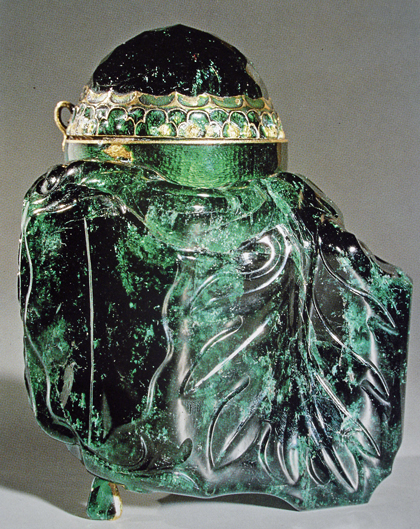Often used in funerary rituals, archaeologists believe the unguentariums were containers used for holding perfumed oils, ointments, balsam. jasmine, kohl, honey, mastic, incense, scent powders and cosmetic preparations.
The “Emerald Unguentarium” in the Imperial treasury (Schatzkammer) in Vienna was commissioned by the Hapsburg king, Emperor Ferdinand III in 1641. Carved out of a single large emerald crystal of Colombian origin, probably over 3,000 carats in weight, it was perhaps the largest emerald crystal discovered in the world at that time.
The 2,680 carat Emerald Unguentarium is shaped more like a bottle, and appears somewhat irregular in shape. The cutter of the enormous emerald twin crystal that had grown together, perhaps instructed by the king to reduce losses, seemed to have followed the shape of the natural crystal to minimize the loss.
The unguentarium had a dome-shaped lid and feet also made of emerald, probably worked from the material scooped out of the vessel. Facets of different shapes were also created and polished to bring out the intrinsic beauty of the emerald.
The ungentarium shows a deep vivid green, characteristics of emeralds originating in the Muzo mines of Columbia. The clarity and transparency seen on the upper facets seem exceptional.
In the year of 1660, the emerald vessel was estimated to have a value of 300,000 Talers. It is now on display in the Kunsthistorisches Museum in Vienna, Austria.
Image credit: Internetstones.com
